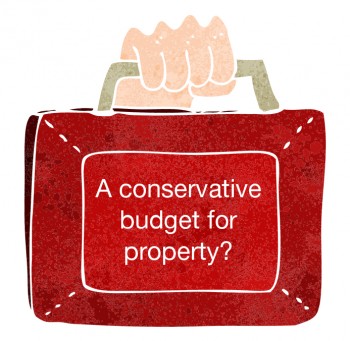Blog
A conservative budget for property?
Tuesday, April 12, 2016

With global finance risks and Brexit uncertainty influencing UK growth and limiting the options, George Osborne’s March budget was never likely to contain any major policy announcements. But the Conservatives have traditionally championed the homeowner’s cause and some meaningful housing initiatives were certainly hoped for when the Chancellor delivered his budget in mid-March. It was something of a disappointment for the UK residential market therefore to discover that previously announced Stamp Duty and tax relief changes were to go ahead with few bonuses UK homebuyers. No mention was made of plans to increase much needed housing supply despite previous budgets encouraging the use of public land to address the issue. So what was there in the Chancellor’s plans to make an impact on the property market?
Lifetime ISA
One of the issues that attracted most interest was the welcome announcement of a Lifetime ISA scheme designed to help first time buyers to save by providing them with the financial incentive to do so. The mechanics are simple - open a Lifetime ISA account between the ages of 18 and 40, save up to £4,000 each year, and receive a 25% government bonus of up to £1,000 a year. You can use some or all of the money to buy your first home, or keep it until you’re 60. Accounts will be available from April 2017 at which time the total amount you can save each year into all ISAs will also be increased from £15,240 to £20,000. The savings and the bonus from the Lifetime ISA can be used towards a deposit on a first home worth up to £450,000. Accounts are limited to one per person rather than one per home so two first time buyers can both receive a bonus when buying together. Help to Buy ISA accountholders can transfer those savings into the Lifetime ISA in 2017, or continue saving into both – but will only be able to use the bonus from one or the other to buy a house.
Commenting on the lifetime ISA announced in the Chancellor's Budget, Mark Hayward, MD of the National Association of Estate Agents, said: “The Chancellor’s announcement that a new lifetime ISA could be used to help people buy their first home is welcome news. Helping first-time-buyers (FTBs) to get on the housing ladder should be a priority for the government, limiting this to those aged 40 or under emphasises the real issues for those trying to get on the housing ladder. Our recent Housing 2025 report forecast that house prices will soar by 50% by 2025, meaning that the task of helping FTBs to get on the first rung of the housing ladder is only set to get more difficult for many people across the UK.”
Buy-to-let stamp duty
The new 3% stamp duty rate increase for buy-to-let investors on second and subsequent properties was confirmed and is good news for first-time buyers looking to get on the property ladder. The government wants to increase homeownership and sees this as a way to stop landlords and investors from crowding first-time buyers out of the housing market. It may steady prices at the lower end of the market which, alongside Help to Buy and shared ownership, may give first-time buyers access to the property ladder.
For landlords, however, there’s no disguising that it’s a significant blow to the bottom line, made only marginally more palatable by its application across the board to include larger institutional investors as well as smaller landlords. With increased pressure on the bottom line from reduced mortgage tax relief, savvy investors and landlords will need to look even more carefully for locations that not only offer decent rental income but are likely to deliver capital appreciation, for example in areas which stand to benefit from Crossrail-related price growth.
What is clear is that sound advice for landlords and investors is more valuable now than ever before. It’s not just about landlords increasing their rents to compensate (although this is likely to be an initial reaction). Many tenants are already paying what they can afford. It may be worth considering added value, through improved services or property management for example, to justify a premium rental and attract tenants who are able to pay more. Advice on what type of property you offer may also be critical. For those buying now, it’s a good idea to seek advice from a lettings agent as to what makes most sense economically and to ask the sales team to help you find the best property to meet those criteria. If you already have a property, consider ways to increase the rental income by upgrading what it offers and maximising its potential.
Fears were allayed for those worried about the prospect of temporarily owning two properties whilst trying to sell one of them. The grace period during which those who have an overlap between two properties can claim a refund on the higher rates has been extended to 36 months, from the originally suggested 18 months, giving them some breathing room.
Commercial Stamp Duty
Mirroring the residential stamp duty “slice system”, reforms to stamp duty rates for commercial property were announced which, combined with a decrease in business rates, should stimulate the market and assist small business owners. With immediate effect, commercial stamp duty will be zero on properties up to £150,000 and 2% on the next £100,000, but a top rate of 5% on £250,000. These changes are likely to be welcomed by small business owners and property investors with 90% seeing their tax bills cut or staying the same. Lot sizes of under £1 million will pay less tax but the main impact will be on vendors of properties over £1.05m and the 5% top rate band may affect the market for larger commercial properties.
Business rate cuts
The changes to business rate thresholds are especially welcome to small businesses. Those with a property with a rateable value of £12,000 or less will pay no rates, while those with a rateable value from £12,000 - £15,000 will receive tapered relief from 1 April 2017. This will reduce property costs for occupiers of small offices and industrial units. This may, however, increase demand for smaller units and lead to rent increases.
Insurance Premium Tax rises
The additional rise announced in the standard rate insurance premium tax is only a small increase, from 9.5% to 10% but comes on top of the 3.5% rise levied last November, and may stretch people already juggling the cost of home ownership. Home insurance is an essential product, there to protect what is most people's most valuable asset and the danger is that it may put people off buying home insurance policies. Proceeds from this will support much needed flood defence work in places such as Calder Valley and Cumbria which hit the headlines in 2015-16.
So all in all, no radical measures in George Osborne's Spring Budget, but plenty to watch unfold across the residential lettings market in particular. The health of the private rental sector is vital in the UK housing market, with up to a quarter of all households predicted to be a part of it by 2025. Many landlords will be weighing up their options in light of the recent measures, but with all-time low interest rates on savings and a volatile stock market, property remains a solid investment especially if prices continue to rise. With demand and rents increasing landlords can still confidently invest especially if they seek professional advice from letting experts to ensure they keep abreast of legislative changes and maximise the potential of their rental property.















